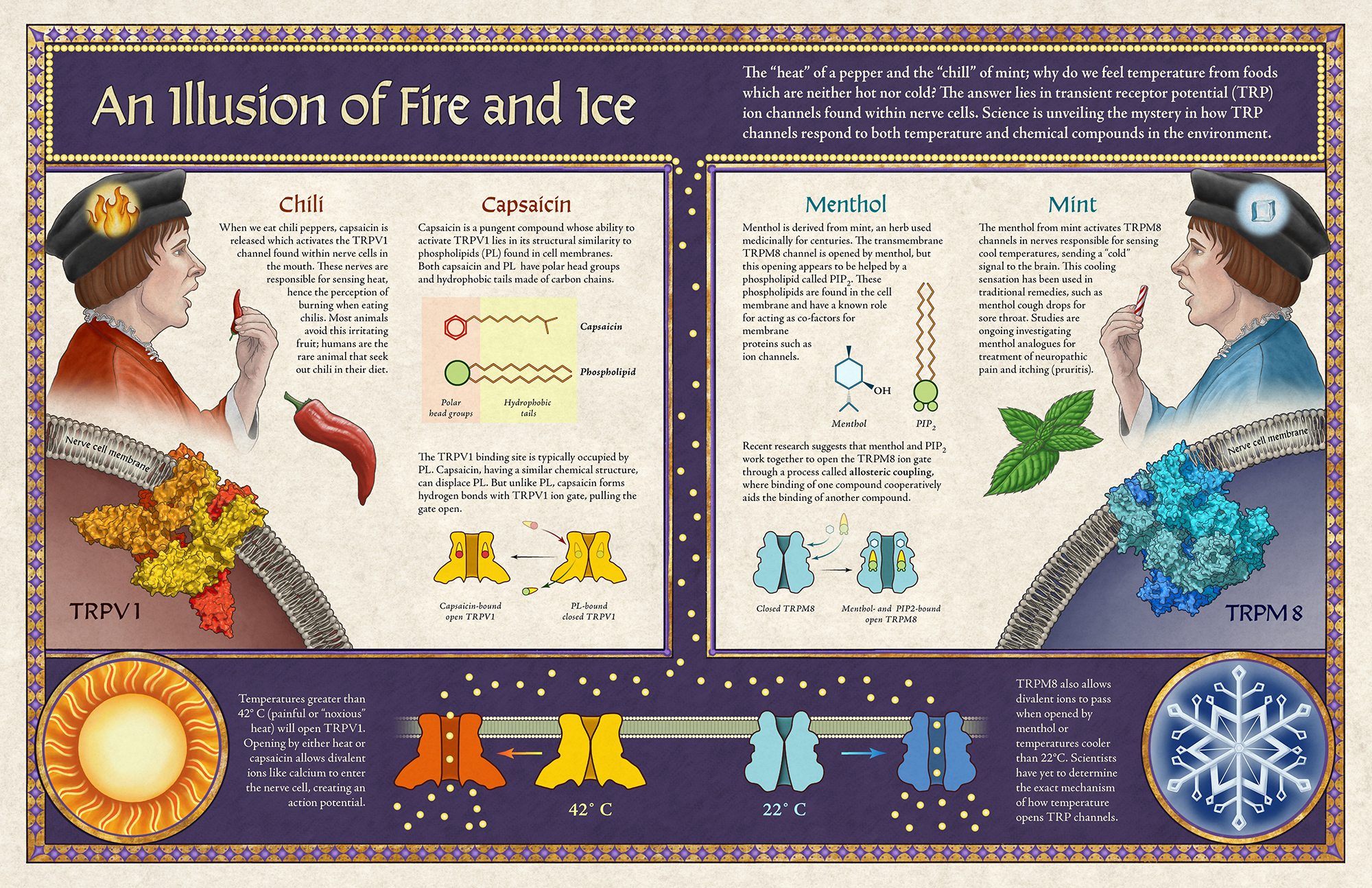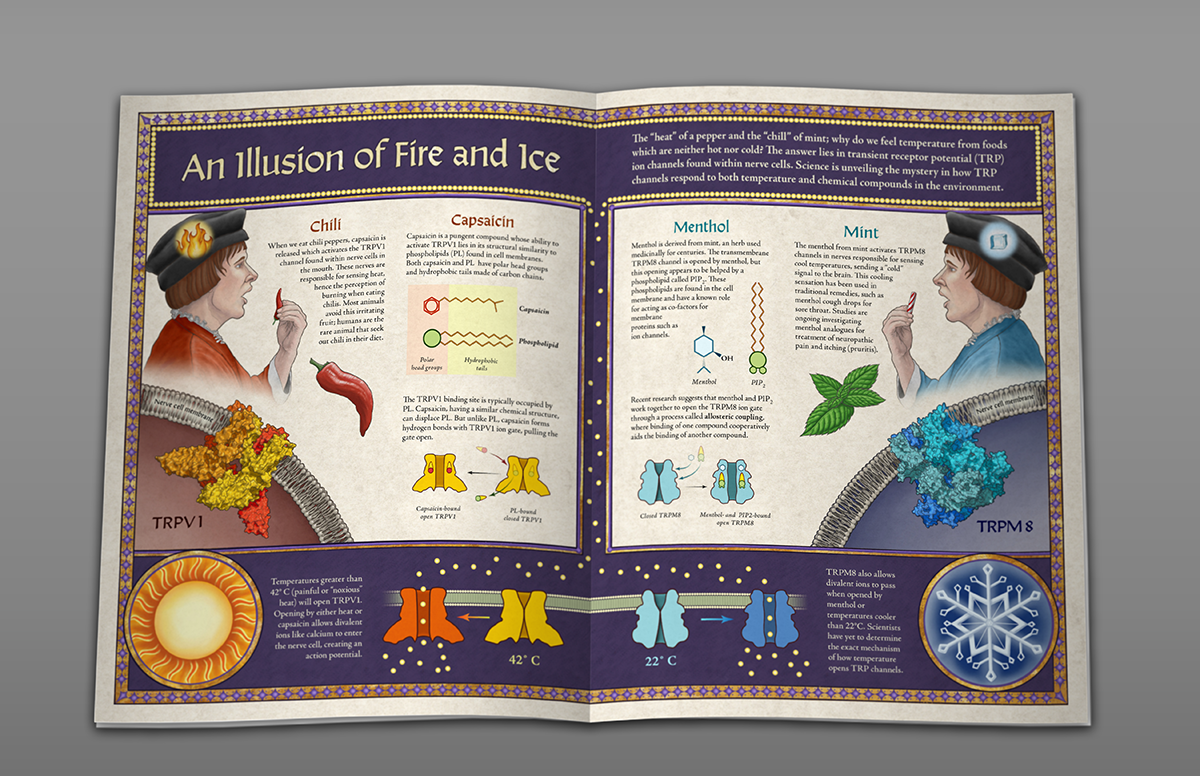It is critical for an organism’s survival to sense harmful environmental conditions, such as heat and cold. Transient receptor potential (TRP) ion channels are molecules found on nerve cell membranes which respond to heat and cold, allowing organisms to sense thermal stimuli. Curiously, TRP channels are also responsive to chemicals, such as capsaicin (found in chili peppers) and menthol (found in mint). I created this two-page mock spread for a popular science magazine, such as Scientific American. My intent was to inform a lay audience on the molecular mechanism which underlies a person’s perception of temperature when eating chili peppers or mint. The design was inspired by medieval illuminated manuscripts, with decorative elements emphasizing the molecular mechanisms. Protein models were obtained from the Protein Data Base (PDB) and further developed in UCSF Chimera. Lipid bilayers were modeled in Cinema 4D, and composite molecule/bilayer models underwent non-photorealistic rendering in ZBrush. Additional assets were developed in Procreate, Photoshop and Illustrator, with final composition and graphic design done in Illustrator.
Audience:
Educated layperson
Date:
July 2019
Supervisor:
Prof. Derek Ng
Format:
Print
Media:
UCSF Chimera, Maxon Cinema 4D, Pixologic ZBrush, Adobe Photoshop, Adobe Illustrator, Savage Interactive Procreate
References:
1. Cao, E., Liao, M., Cheng, Y. & Julius, D. TRPV1 structures in distinct conformations reveal activation mechanisms. Nature 2013. 504, 113–118.
2. Cao, E., Cordero-Morales, J. F., Liu, B., Qin, F. & Julius, D. TRPV1 Channels Are Intrinsically Heat Sensitive and Negatively Regulated by Phosphoinositide Lipids. Neuron 2013. 77, 667–679.
3. Falkenburger, B. H., Jensen, J. B., Dickson, E. J., Suh, B. C. & Hille, B. Phosphoinositides: Lipid regulators of membrane proteins. J. Physiol.2010. 588, 3179–3185.
4. Gao, Y., Cao, E., Julius, D. & Cheng, Y. TRPV1 structures in nanodiscs reveal mechanisms of ligand and lipid action. Nature 2016. 534, 347–351.
5. González-Muñiz, R., Bonache, M. A., Martín-Escura, C. & Gómez-Monterrey, I. Recent Progress in TRPM8 modulation: An update. Int. J. Mol. Sci. 2019. 20, 2618.
6. Kamatou, G. P. P., Vermaak, I., Viljoen, A. M. & Lawrence, B. M. Menthol: A simple monoterpene with remarkable biological properties. Phytochemistry 2013. 96, 15–25.
7. López-Romero, A. E. et al. TRP ion channels: Proteins with conformational flexibility. Channels 2019. 13, 207–226.
8. Nilius, B. & Szallasi, A. Transient Receptor Potential Channels as Drug Targets: From the Science of Basic Research to the Art of Medicine. Pharmacol. Rev. 2014. 66, 676–814.
9. Tewksbury, J. J. et al. Evolutionary ecology of pungency in wild chilies. Proc. Natl. Acad. Sci. U. S. A. 2008. 105, 11808–11.
10. Yang, F. & Zheng, J. Understand spiciness: mechanism of TRPV1 channel activation by capsaicin. Protein Cell 2017. 8, 169–177.
11. Yin, Y. et al. Structural basis of cooling agent and lipid sensing by the cold-activated TRPM8 channel. Science 2019. 363, pii:eaav9334.
12. Yin, Y. et al. Structure of the cold- and menthol-sensing ion channel TRPM8. Science (80-. ). 359, 237–241 (2017).
TRPV1 PDB reference numbers: 3J5P and 5IRZ
TRPM8 PDB reference numbers: 6BPQ
Capsaicin: PubChem ID number 1548943
Menthol: PubChem ID number 1254


